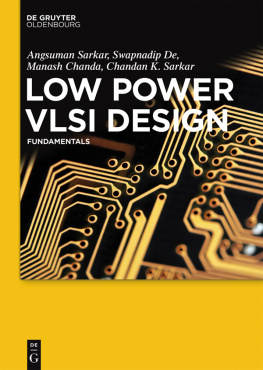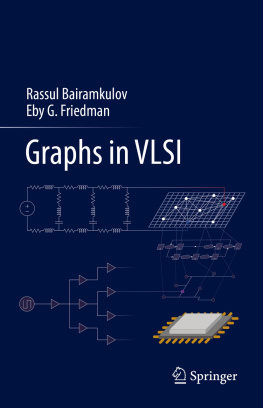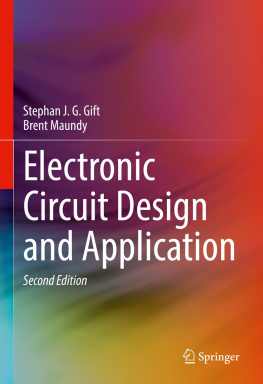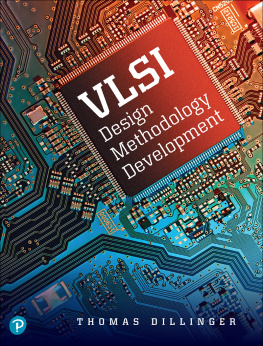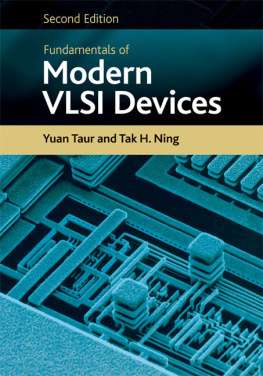Low Power VLSI Design
Guide

Angsuman Sarkar, Swapnadip De, Manash Chanda, Chandan Kumar Sarkar
Low Power VLSI Design
Also of interest

Chaotic Secure Communication
K. Sun, 2016
ISBN 978-3-11-042688-5, e-ISBN 978-3-11-043406-4,
e-ISBN (EPUB) 978-3-11-043326-5, Set-ISBN 978-3-11-043407-1

Nano Devices and Sensors
J. J. Liou, S.-K. Liaw, Y.-H. Chung (Eds.), 2016
ISBN 978-1-5015-1050-2, e-ISBN 978-1-5015-0153-1,
e-ISBN (EPUB) 978-1-5015-0155-5, Set-ISBN 978-1-5015-0154-8

Systems, Automation and Control
N. Derbel (Ed.), 2016
ISBN 978-3-11-044376-9, e-ISBN 978-3-11-044843-6,
e-ISBN (EPUB) 978-3-11-044627-2, Set-ISBN 978-3-11-044844-3

Power Electrical Systems
N. Derbel (Ed.), 2016
ISBN 978-3-11-044615-9, e-ISBN 978-3-11-044841-2,
e-ISBN (EPUB) 978-3-11-044628-9, Set-ISBN 978-3-11-044842-9

Authors
Dr. Angsuman Sarkar
Kalyani Government Engineering College
Kalyani, India
Dr. Swapnadip De
Meghnad Saha Institute of Technology
Kolkata, India
Manash Chanda
Meghnad Saha Institute of Technology
Kolkata, India
Prof. (Dr.) Chandan Kumar Sarkar
Jadavpur University
Kolkata, India
ISBN 978-3-11-045526-7
e-ISBN (PDF) 978-3-11-045529-8
e-ISBN (EPUB) 978-3-11-045545-8
Set-ISBN 978-3-11-045555-7
Library of Congress Cataloging-in-Publication Data
A CIP catalog record for this book has been applied for at the Library of Congress.
Bibliographic information published by the Deutsche Nationalbibliothek
The Deutsche Nationalbibliothek lists this publication in the Deutsche Nationalbibliografie; detailed bibliographic data are available on the Internet at http://dnb.dnb.de.
2016 Walter de Gruyter GmbH, Berlin/Boston
Cover image: MauMyHaT/iStock/thinkstock
Typesetting: Integra Software Services Pvt. Ltd.
www.degruyter.com
This book is dedicated to our parents and family members for their love and support.
Preface
Designing of integrated circuits (ICs) requires expertise in different areas including device physics, transistor-level design and logic-level design. An attempt has been made to cover all these topics reinforced with physical and intuitive explanations and necessary simulation analysis for better understanding of the theory. The goal of this book is to emphasize the basic physical principles and physics of transistors and behavior of circuits that can be used to explain and confront the challenging low power issues in digital and analog very-large-scale integration (VLSI) design in a comprehensive manner with a focus on predominant complementary metaloxidesemiconductor (CMOS) technology.
An attempt has also been made to adopt a hierarchical design methodology for digital and analog energy-reduced low power VLSI design by analyzing theory and key concepts in an organized manner to provide the reader an insightful, practical guide. This book does not try to recommend specific software tools. In contrast, the main objective of this book is to demonstrate a proper path to the reader to face the challenges of low power VLSI design through a maze of names, concepts, methodologies, software tools and usage.
The purpose of this book is to present and explain in a coherent manner all the know-how of low power digital and analog VLSI design. For each chapter/topic, the book discusses several basic approaches and elaborates on the more fundamental ones. A list of complete references/bibliography has been included at the end of each chapter to provide extensive coverage of the topics by providing a list of many of the classic books/papers dealing with the findings which are considered landmarks in the VLSI industry. An attempt has been made to include all recent papers on emerging topics which are appropriate for the targeted readers of this text.
In the following, a series of capsule description of the seven chapters in the book has been introduced.
Chapter 1: Introduction to Low Power Issues in VLSI. This chapter presents an overview of the low voltage, low power digital and analog ICs and their applications, and also the context of the book and its motivations.
Chapter 2: Scaling and Short Channel Effects in MOSFET. gives a brief introduction to the short channel effects and their preventions
Chapter 3: Advanced Energy-reduced CMOS Inverter Design. This chapter is concerned with the theory of inverters, known as the basic building block of the digital ICs, to set a solid foundation to understand the rest of this book by discussing basic operation and other advanced issues in both super-threshold and subthreshold regions of operation.
Chapter 4: Advanced Combinational Circuit Design. The topic on this chapter focuses on the design principles of combinational digital logic circuits with an objective to make them fast, small and reliable. After providing a preliminary review of the basic concepts of combinational digital logic design using different approaches, a number of design examples are demonstrated, followed by ultralow power implementation of combinational circuits.
Chapter 5: Advanced Energy-reduced Sequential Circuit Design. The objective of this chapter is to deal with advanced sequential circuit design techniques for clocked logic structures that are fast, reliable, energy-efficient and race-free. The chapter also discusses the energy-efficient implementation of sequential circuits with introduction to adiabatic logic.
Chapter 6: Introduction to Memory Design. This chapter considers the technological issues necessary to comprehend the design and operation of low power, high speed MOS-based memory systems. The evolution of memory design over the years has been described briefly. This chapter shows the way to design various types of ROMs and RAMs. The features and architectures of latest memories available in the market are also presented.
Chapter 7: Analog Low Power VLSI Circuit Design. The purpose of this chapter is to present the design techniques of low power analog ICs and the fundamental issues associated with the design of analog/mixed-signal system-on-chip design.
1Introduction to Low Power Issues in VLSI
1.1Introduction to VLSI
This chapter gives a brief description of low power digital and analog very-large-scale integration (VLSI) design. It is also treated as a review of basic principles rather than an in-depth treatment of individual advanced topics.
Over the last two decades, wireless communication is considered as one of the major successes of engineering, not only due to its huge technological growth, but also due to its societal and economic impact. The evolution of wireless communication is directly linked to power consumption of the devices. The gap between small-sized battery capacity and power requirement has become a critical factor to be considered for most hand-held portable wireless devices. Thus, energy efficiency and low power design has become one of the most important topics in integrated circuit (IC) design.

